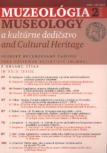Legislatívna ochrana kultúrneho dedičstva v Československej republike v rokoch 1918 – 1939
The legislative framework of the protection of cultural heritage in 1918-1939 Czechoslovakia
Author(s): Martina OrosováSubject(s): Cultural history, Museology & Heritage Studies, Pre-WW I & WW I (1900 -1919), Interwar Period (1920 - 1939)
Published by: Univerzita Komenského v Bratislave, Filozofická fakulta
Keywords: Czechoslovakia; cultural heritage; legal framework; laws and regulations; protection of cultural heritage; museums and archives; archeology; artifact export;
Summary/Abstract: This paper analyzes laws and regulations governing the protection of cultural heritage (whether original measures or measures inherited from the legal systems of Austria and Hungary) adopted by the Czechoslovak republic in the period between the two world wars. It focuses on laws and regulations in force in Slovakia, comparing them to corresponding measures in national or Czech legal frameworks and finding that the primary purpose of such legislation was to prevent the export of movable cultural artifacts and that the legal framework of protection of cultural heritage in Slovakia was equivalent to that adopted in the Czech lands. In practical terms, however, both frameworks were of ad hoc and provisional nature and remained so until the beginning of World War II with the lack of political as the main reason for the failure to implement a truly national and comprehensive legal framework of protection of cultural heritage.
Journal: Muzeológia a kultúrne dedičstvo
- Issue Year: 1/2013
- Issue No: 2
- Page Range: 19-36
- Page Count: 18
- Language: Slovak

